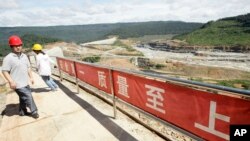In Cambodia, a number of hydropower dams have already been constructed, and even more are on the way. But environmentalists warn the dams can have serious ecological and social impacts.
A total nine hydropower dams are slated for completion by 2019, able to produce enough energy to power the country. But experts warn the trade-offs won’t be worth it. “We can find other alternatives, such as solar and wind energy, biomass and decentralization of small scale energy production for local consumption,” said Youk Senglong, program manager for the Fisheries Action Coalition Team.
Food security and livelihoods for millions of people are at risk, along with wildlife and fish along the Mekong and other rivers, as dams seriously affect hydrologic and other ecological systems, he said.
China, meanwhile, has agreements to construct at least six more dams across the country, at a cost of $1.6 billion, to produce more than 900 megawatts of power across several provinces.
Cambodia’s dams so far include: Kamchay dam in Kampot, 193 megawatts; Tatay in Koh Kong, 246 megawatts; Russei Chrum Krom in Koh Kong, 338 megawatts; and Kirirom III in Kompong Speu, 18 megawatts. Three more dams which are under construction: Atay in Koh Kong; Lower Sesan II in Steung Treng; and O' Soam in Pursat. Three dams are under feasibility studies: Steung Treng, Sambo and Areng.
According to a study by Cambodia’s Fishery Administration, dam constructions along the Mekong River will reduce Cambodian fish consumption per capita from 49 kilograms to 22 kilograms per year due to a decrease in fish populations.
“Hydropower dam construction makes fish unable to migrate from the downstream to upstream so it will threaten the fish stock,” said Tek Vannara, executive director of NGO Forum Cambodia. “This makes the people who depend on fish lose their occupations.”
Youk Senglong said the dams most severely affecting people’s livelihoods are Laos’ Don Sahong dam, which is just 1.5 kilometers from Cambodia’s border, and Lower Sesan II, as they are major fish migration routes for reproduction.
According to a study in 2012 the National Academy of Sciences, the Lower Sesan II dam will reduce fish stocks in the Mekong Basin by 9.3 percent and threaten more than 50 fish species, as well as reduce sediment flow from 6 percent to 8 percent. More than 5,000 people will be forced to relocate.
Dam Samnang, a villager who lives near a dam site, said the company there is preparing for dam construction now, even though the local people continue to live there and reject the compensation scheme.
“For me and other villagers, we don’t want the dam to be constructed without comprehensive study,” he said. “If it is constructed, it will affect the whole region, especially ethnic minorities and Cambodian people who live along the confluence of the two rivers.”
The company has offered 5 hectares of land for housing and farming to each family as compensation, but the villagers insist on an independent evaluator for a compensation scheme, he said.
Sao Sopheap, spokesman at Ministry of Environment, said the government does insist on environmental and social impact assessments before dams are built.
But Tek Vannara says that dam construction in Cambodia lacks transparency and participation from local communities, and that the environmental and social impact assessments are too weak to address actual impacts.
“I don’t mean we cannot build the dam, but the study must be comprehensive, and benefits must be equitably shared with the local people and minimize effects on them,” Han Poumin, energy economist at Indonesia based-ERIA Institute, said. “Relocation and loss of traditional livelihoods need a package solution.”







